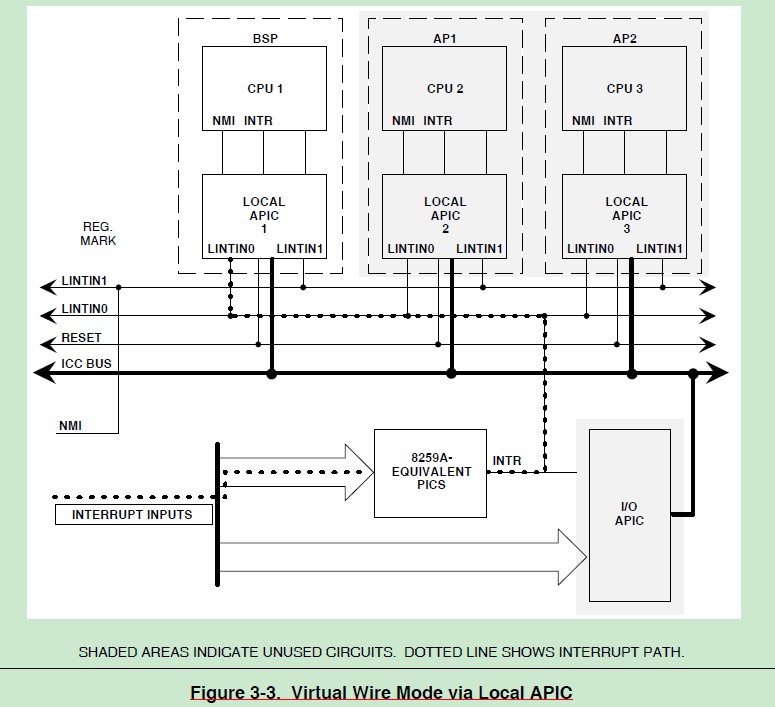3.6.2.1 PIC Mode
PIC Mode is software compatible with the PC/AT because it actually employs the same hardware
interrupt configuration. As Figure 3-2 illustrates, the hardware for PIC Mode bypasses the APIC
components by using an interrupt mode configuration register (IMCR). This register controls
whether the interrupt signals that reach the BSP come from the master PIC or from the local APIC.
Before entering Symmetric I/O Mode, either the BIOS or the operating system must switch out of
PIC Mode by changing the IMCR. 3.6.2.2 Virtual Wire Mode
In Virtual Wire Mode, as shown in Figure 3-3, the 8259A-equivalent PIC fields all interrupts, and
3.6.2.2 Virtual Wire Mode
In Virtual Wire Mode, as shown in Figure 3-3, the 8259A-equivalent PIC fields all interrupts, and
the local APIC of the BSP becomes a virtual wire, which delivers interrupts from the PIC to the
BSP via the local APIC’s local interrupt 0 (LINTIN0). The LINTIN0 pin of the local APIC is
programmed as ExtINT, specifying to the APIC that the PIC is to serve as an external interrupt
controller. Whenever the local APIC finds that a particular interrupt is of type ExtINT, it asserts
the ExtINTA transaction along with the PINT interrupt to the processor. In this case, the I/O APIC
is not used. Figure 3-3 shows how Virtual Wire Mode can be implemented through the BSP’s local APIC. It is
Figure 3-3 shows how Virtual Wire Mode can be implemented through the BSP’s local APIC. It is
also permissible to program the I/O APIC for Virtual Wire Mode, as shown in Figure 3-4. In this
case the interrupt signal passes through both the I/O APIC and the BSP’s local APIC. 3.6.2.3 Symmetric I/O Mode
Some MP operating systems operate in Symmetric I/O Mode. This mode requires at least one I/O
3.6.2.3 Symmetric I/O Mode
Some MP operating systems operate in Symmetric I/O Mode. This mode requires at least one I/O
APIC to operate. In this mode, I/O interrupts are generated by the I/O APIC. All 8259 interrupt
lines are either masked or work together with the I/O APIC in a mixed mode. See Figure 3-5 for
an overview of Symmetric I/O Mode.
PIC Mode is software compatible with the PC/AT because it actually employs the same hardware
interrupt configuration. As Figure 3-2 illustrates, the hardware for PIC Mode bypasses the APIC
components by using an interrupt mode configuration register (IMCR). This register controls
whether the interrupt signals that reach the BSP come from the master PIC or from the local APIC.
Before entering Symmetric I/O Mode, either the BIOS or the operating system must switch out of
PIC Mode by changing the IMCR.
 3.6.2.2 Virtual Wire Mode
In Virtual Wire Mode, as shown in Figure 3-3, the 8259A-equivalent PIC fields all interrupts, and
3.6.2.2 Virtual Wire Mode
In Virtual Wire Mode, as shown in Figure 3-3, the 8259A-equivalent PIC fields all interrupts, andthe local APIC of the BSP becomes a virtual wire, which delivers interrupts from the PIC to the
BSP via the local APIC’s local interrupt 0 (LINTIN0). The LINTIN0 pin of the local APIC is
programmed as ExtINT, specifying to the APIC that the PIC is to serve as an external interrupt
controller. Whenever the local APIC finds that a particular interrupt is of type ExtINT, it asserts
the ExtINTA transaction along with the PINT interrupt to the processor. In this case, the I/O APIC
is not used.
 Figure 3-3 shows how Virtual Wire Mode can be implemented through the BSP’s local APIC. It is
Figure 3-3 shows how Virtual Wire Mode can be implemented through the BSP’s local APIC. It isalso permissible to program the I/O APIC for Virtual Wire Mode, as shown in Figure 3-4. In this
case the interrupt signal passes through both the I/O APIC and the BSP’s local APIC.
 3.6.2.3 Symmetric I/O Mode
Some MP operating systems operate in Symmetric I/O Mode. This mode requires at least one I/O
3.6.2.3 Symmetric I/O Mode
Some MP operating systems operate in Symmetric I/O Mode. This mode requires at least one I/OAPIC to operate. In this mode, I/O interrupts are generated by the I/O APIC. All 8259 interrupt
lines are either masked or work together with the I/O APIC in a mixed mode. See Figure 3-5 for
an overview of Symmetric I/O Mode.
